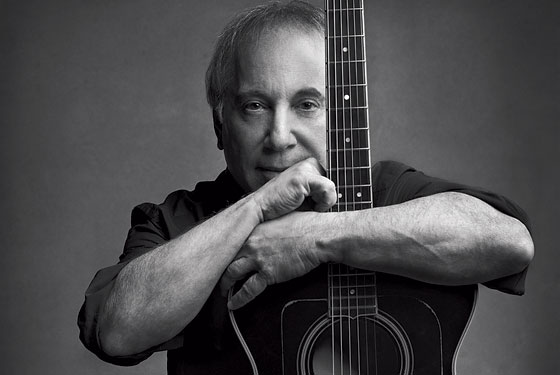Paul Simon Introduces 'Stranger to Stranger' | reviews, news & interviews
Paul Simon Introduces 'Stranger to Stranger'
Paul Simon Introduces 'Stranger to Stranger'
Not so crazy after all these years

Perhaps as a hopeful harbinger for Paul Simon's new album Stranger to Stranger, Disturbed recently topped Billboard's Mainstream Rock Songs chart with their flabbergasting version of Simon's 1965 song "The Sound of Silence". However, while vocalist David Draiman could launch a career as a new kind of Wagnerian baritone on the strength of his extraordinary performance, Simon himself is headed in a less stentorian direction.
A track like "Cool Papa Bell" might get you thinking for a moment about what Graceland did next, but "The Werewolf " is what could have happened if Lon Chaney Jr had got into a barroom brawl with Steve Reich. "Wristband" (the first single) is a jazzy, bluesy parable about the chosen and the excluded, propelled by slinky handclaps and rubbery string bass. "The Riverbank" might be termed Afro-rockabilly.
 At a promotional appearance for the album at the Ham Yard hotel in Soho, Simon, now 74, kicked off by delivering a lengthy discourse on the musical theories and microtonal compositions of California-born iconoclast Harry Partch. It's not often you hear a pop singer-songwriter holding forth about how you can divide an octave into 43 microtones, or for that matter why some symphony orchestras prefer their A notes to be tuned to 444 cycles per second instead of the conventional 440.
At a promotional appearance for the album at the Ham Yard hotel in Soho, Simon, now 74, kicked off by delivering a lengthy discourse on the musical theories and microtonal compositions of California-born iconoclast Harry Partch. It's not often you hear a pop singer-songwriter holding forth about how you can divide an octave into 43 microtones, or for that matter why some symphony orchestras prefer their A notes to be tuned to 444 cycles per second instead of the conventional 440.
True, Simon had been steered onto the topic of Partch by his interviewer, Paul Gambaccini, but he seemed to take a mischievous delight in spinning his answer out at professorial length. After all, he does have an honorary doctorate from Berklee College of Music. Still, circuitously or not, it all played into the bigger picture of how he conceived and recorded Stranger to Stranger. For instance, the track "Insomniac's Lullaby" got its name after Simon's wife, Edie Brickell, thought it sounded like a lullaby when he played it to her on guitar. Simon didn't agree, unless it might be a lullaby for the chronically sleepless. In which case, he thought that applying the faintly unsettling sound of Partch's bizarre homemade instruments (which include Cloud-Chamber Bowls and the Chromelodeon) and their slithering tonalities might be the perfect solution.
The objective Simon had set himself for the album was to create "a sense of space and instruments blending in a way that is entertaining and interesting," as he put it. "And really thinking that if I don't make it entertaining and interesting, the truth is that nobody's going to listen to it, because for the most part nobody listens to anything really. It's hard to get people to listen to music, except for very young pop music which has got a strong hook or is dance music. But if you're writing music that comes from way back in the singer-songwriter world, in order to make that music modern and not purely a used-up form, the sounds have to be interesting and fresh to the ear, and how they're integrated has to have a certain beauty to it."
 To this end, Simon has developed some intriguing strategies. Believing that "the length of the songs has to vary in such a way that your attention span is not taxed", he broke up the longer full-band pieces with some brief, pared-down tracks – "The Clock", "In the Garden of Edie" and "Guitar Piece 3". He also explained how within songs themselves, he has devised various ploys for keeping the listener awake and paying attention.
To this end, Simon has developed some intriguing strategies. Believing that "the length of the songs has to vary in such a way that your attention span is not taxed", he broke up the longer full-band pieces with some brief, pared-down tracks – "The Clock", "In the Garden of Edie" and "Guitar Piece 3". He also explained how within songs themselves, he has devised various ploys for keeping the listener awake and paying attention.
"If I say something by either using an unusual image or a thought that requires a second to think about, I'll usually follow that with a cliché, for enough time so that while you're digesting this more unusual thought you're really not losing anything as the song continues. To me, that seems like one of the requirements of writing songs that have something to say. Most of the time, if you make them too dense, you can't follow them. Songs are not the natural form of complex thinking or dense thinking. It's easier to absorb that from the page, where you can go at your own pace. A song has got its own tempo and you're forced to go at the tempo of the composer."
A song also has its own key, another area Simon has pondered over at length. He usually starts off writing in the "sharp" keys because they're the guitar-friendly ones (D, A and E for instance), "but at a certain point I say it's time to introduce flat keys now or the whole album is going to feel very guitar-y. So I start to put things into F or E flat or A flat."
 A case in point was "Street Angel", where he used some recordings of gospel singers the Golden Gate Quartet as part of a percussion-dominated musical mix. The Quartet were singing too high, so Simon slowed them down and then played them backwards. This created an additional beneficial effect, in that the backwards recording sounded as if it was saying the words "street angel".
A case in point was "Street Angel", where he used some recordings of gospel singers the Golden Gate Quartet as part of a percussion-dominated musical mix. The Quartet were singing too high, so Simon slowed them down and then played them backwards. This created an additional beneficial effect, in that the backwards recording sounded as if it was saying the words "street angel".
"I really like it when the idea for the song comes from outside and not within," Simon added. "I like to respond to the stimuli. It's more fun to edit than it is to face a blank page. These sounds and the way they sounded backwards were the lyrics that I used – 'took him away in an ambulance' was another example. It becomes an interesting story that I'm relating to the listener from someone else's narrative."
As for Gambaccini's thesis that the underlying theme of Stranger to Stranger is death and mortality, Simon wasn't buying.
"There's no particular lyrical theme – it's just the thoughts that go through your head, and a lot of it is jokes to me. Political, fashion, whatever is crossing my mind and feels like it belongs in that rhythm or that musical context is good enough for me to say 'Yeah, I like it and I'll keep it in the song'. It's not a deep insight or anything. It's been said before, but it's fine, it's just there to be an entertainment. If there is a theme, it's a musical theme of sound, and maybe it's a bit more personal on some of the songs than I might have written in the past."
- Stranger to Stranger is released on Concord Records on 3 June
Share this article
The future of Arts Journalism
You can stop theartsdesk.com closing!
We urgently need financing to survive. Our fundraising drive has thus far raised £49,000 but we need to reach £100,000 or we will be forced to close. Please contribute here: https://gofund.me/c3f6033d
And if you can forward this information to anyone who might assist, we’d be grateful.

Subscribe to theartsdesk.com
Thank you for continuing to read our work on theartsdesk.com. For unlimited access to every article in its entirety, including our archive of more than 15,000 pieces, we're asking for £5 per month or £40 per year. We feel it's a very good deal, and hope you do too.
To take a subscription now simply click here.
And if you're looking for that extra gift for a friend or family member, why not treat them to a theartsdesk.com gift subscription?
more New music
 Lily Allen's 'West End Girl' offers a bloody, broken view into the wreckage of her marriage
Singer's return after seven years away from music is autofiction in the brutally raw
Lily Allen's 'West End Girl' offers a bloody, broken view into the wreckage of her marriage
Singer's return after seven years away from music is autofiction in the brutally raw
 Music Reissues Weekly: Joe Meek - A Curious Mind
How the maverick Sixties producer’s preoccupations influenced his creations
Music Reissues Weekly: Joe Meek - A Curious Mind
How the maverick Sixties producer’s preoccupations influenced his creations
 Pop Will Eat Itself, O2 Institute, Birmingham review - Poppies are back on patrol
PWEI hit home turf and blow the place up
Pop Will Eat Itself, O2 Institute, Birmingham review - Poppies are back on patrol
PWEI hit home turf and blow the place up
 'Fevereaten' sees gothic punk-metallers Witch Fever revel in atmospheric paganist raging
Second album from heavy-riffing quartet expands sonically on their debut
'Fevereaten' sees gothic punk-metallers Witch Fever revel in atmospheric paganist raging
Second album from heavy-riffing quartet expands sonically on their debut
 theartsdesk Q&A: Soft Cell
Upon the untimely passing of Dave Ball we revisit our September 2018 Soft Cell interview
theartsdesk Q&A: Soft Cell
Upon the untimely passing of Dave Ball we revisit our September 2018 Soft Cell interview
 Demi Lovato's ninth album, 'It's Not That Deep', goes for a frolic on the dancefloor
US pop icon's latest is full of unpretentious pop-club bangers
Demi Lovato's ninth album, 'It's Not That Deep', goes for a frolic on the dancefloor
US pop icon's latest is full of unpretentious pop-club bangers
 Yazmin Lacey confirms her place in a vital soul movement with 'Teal Dreams'
Intimacy and rich poetry on UK soul star's second LP
Yazmin Lacey confirms her place in a vital soul movement with 'Teal Dreams'
Intimacy and rich poetry on UK soul star's second LP
 Solar Eyes, Hare & Hounds, Birmingham review - local lads lay down some new tunes for a home crowd
Psychedelic indie dance music marinated in swirling dry ice
Solar Eyes, Hare & Hounds, Birmingham review - local lads lay down some new tunes for a home crowd
Psychedelic indie dance music marinated in swirling dry ice
 The Lemonheads' 'Love Chant' is a fine return to form
Evan Dando finally gets back in the saddle with an album of new tunes
The Lemonheads' 'Love Chant' is a fine return to form
Evan Dando finally gets back in the saddle with an album of new tunes
 Music Reissues Weekly: Evie Sands - I Can’t Let Go
Diligent, treasure-packed tribute to one of Sixties’ America’s great vocal stylists
Music Reissues Weekly: Evie Sands - I Can’t Let Go
Diligent, treasure-packed tribute to one of Sixties’ America’s great vocal stylists
 'Deadbeat': Tame Impala's downbeat rave-inspired latest
Fifth album from Australian project grooves but falls flat
'Deadbeat': Tame Impala's downbeat rave-inspired latest
Fifth album from Australian project grooves but falls flat
 Heartbreak and soaring beauty on Chrissie Hynde & Pals' Duets Special
The great Pretender at her most romantic and on the form of her life
Heartbreak and soaring beauty on Chrissie Hynde & Pals' Duets Special
The great Pretender at her most romantic and on the form of her life

Add comment